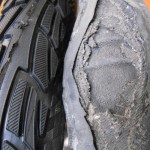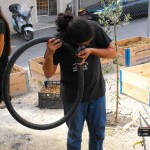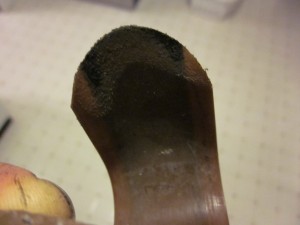Many shops these days (industrialized “first world” ones anyway), may simply opt to replace tires or tubes which are damaged. A bad sidewall may blow out, an old tube may have a hard to find leak. Finding the cause of flats can be a time consuming business if it is not immediately obvious. A tube may have a major hole caused by a puncture but the tube is old or has a slow leak at the valve.  The probability is high that if you find a nail through the tire this was the cause so you usually have to go with the most obvious/ likely answer. But look the parts over for wear and assess the long term future of the parts. Maybe its just time to replace that tread bare tire to help avoid future flats.
The probability is high that if you find a nail through the tire this was the cause so you usually have to go with the most obvious/ likely answer. But look the parts over for wear and assess the long term future of the parts. Maybe its just time to replace that tread bare tire to help avoid future flats.
Pull the tire off one side of the rim with the valve at the top. Keeping the tube oriented with the tire, inflate and check for obvious leaks.  You can rotate it holding it up to your face in order to detect the leak but try not to loose track of the orientation. You’ll need to know where the leak is on the tire so you can remove it.
You can rotate it holding it up to your face in order to detect the leak but try not to loose track of the orientation. You’ll need to know where the leak is on the tire so you can remove it.
If you didn’t find the cause you probably haven’t looked hard enough. Put the inflated tube under water if necessary. Ask if the cause was perhaps removed by the rider but don’t overlook anything. It is very rare that there is not some evidence of what caused the flat. Besides the hard to find metal shard, broken thorn or pinch flat, these are a few others:
Bad valve hole/Valve was not seated:  remove burrs and/ or put on better rim strip to cover around hole. If tube section at valve hole was not seated (valve pulled all the way through rim), punctures can result by side of the valve stem.
remove burrs and/ or put on better rim strip to cover around hole. If tube section at valve hole was not seated (valve pulled all the way through rim), punctures can result by side of the valve stem.
Bad rim strip/ long spokes: replace strip; usually evidenced by tube puncture on underside unless tube severely twisted inside tire. File/ replace spokes.
Bad tire: although a hole in the tire may be hard to find, thread bare sidewall section might have caused flat, esp. if run at high pressure
Bad rim: although rare, some rims have too deep of an inside profile (or tire/ tube combo too large for rim. This can cause the tube to expand or stretch downward toward the rim while still being held in place by the tire. Especially noticeable at valve stem. Removing this space by building up a few rim strips, and using talc and larger tube may help.
Protective tire strips
 Mr tuffy type rim strips can be great for an added layer of flat resistance especially in urban or thorn prone places. They can however be the cause of flats, esp. if the ends are not smoothed out. Make sure the over laping section is not too long and then take the sharp edge of the cut end to the grinder to thin it out. Using a large enough quality tube, talc or even duct tape are all good ideas as the sharp sides of the strip can puncture tubes over time and durring winter riding (tubes are less elastic). Use an extremely puncture resistant tire as an alternative.
Mr tuffy type rim strips can be great for an added layer of flat resistance especially in urban or thorn prone places. They can however be the cause of flats, esp. if the ends are not smoothed out. Make sure the over laping section is not too long and then take the sharp edge of the cut end to the grinder to thin it out. Using a large enough quality tube, talc or even duct tape are all good ideas as the sharp sides of the strip can puncture tubes over time and durring winter riding (tubes are less elastic). Use an extremely puncture resistant tire as an alternative.
Tire too tight to install on rim
Some rim/ tire combos are extremely tight fitting making tube replacement near impossible, esp. out on the road (some older Matrix rims/ Conti tires come to mind). Using a fold-able tire, thin nylon rim-strip (or equivalent threaded tape) or adding tension to the spokes may help. (Perhaps running a Hozan type deburring tool on the underside of the rim bead/lip?!!!: not recomended)
700D tires (583 etrto) found on some older GTs might seem to potentially end a bike’s usefulness but fear not; a more readily available 584 might work or try rebuilding with 584 rims.
